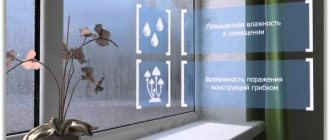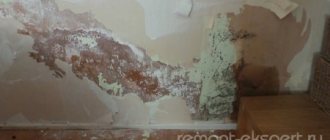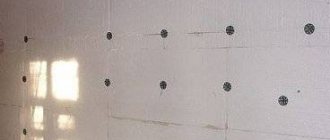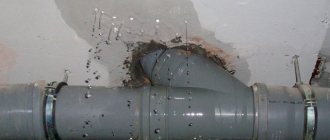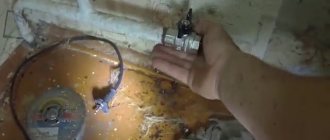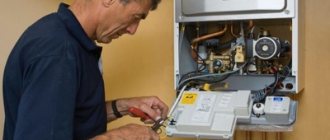Black spots in corners and on walls, dampness, and a putrid smell not only worsen the aesthetics of the room, but are also harmful to health. Residents of houses, especially those built two, three or more decades ago, often complain: “Mold has appeared on the wall in the apartment. What to do? Is it possible to quickly remove harmful plaque?”
The fight against microorganisms that have settled in damp, poorly ventilated areas often drags on for years. Many residents make mistakes, try to mask (paint over) mold stains or simply wipe off the black coating from the wall. It is important to know what to do if your home is attacked by mold. Many people will benefit from advice on how to efficiently remove unsightly stains that pose a threat to the body.
Reasons for appearance
It is important to understand why the walls in an apartment are often covered with a gray-black or yellowish-green coating, with a brown tint. Mold is a toxic fungus that actively settles on stone, brick, plaster, concrete, and wooden surfaces.
Mold deposits indicate a disturbed microclimate: the room is too damp, the ventilation does not meet sanitary standards. The lower the temperature in the apartment with high humidity, the higher the risk of mold growth.
Types of mold:
- mold fungi. They reproduce on painted surfaces, concrete, stone;
- putrefactive fungi. Brown rot corrodes the tree and is difficult to remove;
- Dangerous blue mushrooms are most often active on wooden surfaces. This type of rot prefers pine.
The main reasons for high indoor humidity:
- installation of plastic windows without a sufficient level of air exchange in an apartment or house;
- freezing of poorly insulated walls;
- low room temperature for a long period;
- poor quality brickwork;
- malfunction, absence or incorrect installation of ventilation systems;
- humidity in the house or apartment is above 60%;
- bad habit of almost always keeping the windows closed;
- sewerage leakage causing excess moisture;
- improper installation of insulating material between the vertical and horizontal foundations.
Warning! Not all residents know how dangerous mold colonies are to their health. Microorganisms dry out, turn into dust, fall to the floor or mix with the air, and enter the lungs. Mold particles provoke pulmonary diseases. Patients suffering from bronchitis, asthma, tuberculosis, allergic rhinitis, and frequent colds note an increase in cough when in a damp room. Harmful microorganisms have a negative effect on the immune system and weaken the body.
The elusive “dew point”
Paradoxically, the task of reducing heat loss at any cost sometimes results in constant dampness in the house, not far from the appearance of mold. Mold damage is not just a design flaw. Often it coexists with harmful bacteria, and it itself is capable of releasing spores into the air that are dangerous to human health.
Today we have more or less learned how to fight mold itself; to do this, it is no longer necessary, as in past centuries, to burn the entire house. However, in any case, this is a fight against windmills, that is, the consequences, not the source.
First you need to understand that mold needs moisture, darkness and coolness. And if nothing structurally pours or leaks on the walls (roof and drainage, communications, poor waterproofing of the basement), then the increased construction humidity of new buildings gradually disappears, and the structures go into the so-called equilibrium humidity regime. If this not only does not happen, but the situation even gets worse, the problem is high indoor air humidity.
It has been established that an ordinary family consisting of 4 people releases about 10-15 liters of water per day into the air. Even periodic short-term ventilation “wide open” cannot cope with such a quantity.
In this case, moisture usually forms in the wall-ceiling transitions, in corners, in areas near baseboards, near windows. These places are often perceived as “bridges of cold.” In a certain sense, this is true - moisture condenses on the coldest parts of the surface. However, the problem also arises in those houses that are quite sufficiently insulated. What's the matter?
To do this, you need to take a short excursion into the not-distant past. The main heating element of a traditional house, not necessarily a village hut, was a stove or fireplace. During their work, intensive air exchange took place - a colossal volume of used air was burned out, flying into the chimney, and excess moisture went with it. It was replaced by clean, healthy, oxygen-rich air from the street. We didn't even talk about the tightness of living quarters - you'd be in trouble. The old wooden windows were simply ideal in terms of air exchange and relieved the house of excess moisture.
In contrast to stove heating, modern heating does not have the ability to remove used humid air through the chimney and add fresh air through leaky windows. The use of Euro-windows reduces normal air exchange and leads to a deterioration of the indoor microclimate: air humidity increases, and the concentration of harmful compounds increases. Plus, ordinary convection heating, the operation of which is based on the circulation of heat flows, in the absence of drafts, heats mainly the air around the radiators and leaves many areas of the walls unheated.
The air in the house becomes too humid, condensation forms on the supercooled surface of the walls, and moisture accumulates in the pores of building materials. In order for it to evaporate, thermal energy must be consumed, and it is precisely in places where there is insufficient air circulation that there is not enough of it.
Oddly enough, the problem can often be solved by simply ignoring aesthetic considerations. For example, if the pipes leading to the radiators are not hidden in the floor and walls, but placed along the perimeter at the bottom of the wall. One such open pair of pipes with constant circulation of hot water will help ensure the minimum necessary circulation of air masses. The main thing is not to cover the pipe with a layer of thermal insulation.
As finishing coatings in such places, it is best to use porous lime plasters that are stable against dampness and dry well.
Where does mold appear?
Dampness, lack of sufficient fresh air flow, combined with low temperature are ideal conditions for the development of colonies of fungi, causing the appearance of dark plaque and black spots in various parts of the room. Mold most often affects poorly ventilated areas, places where the housewife does not always get to for cleaning and disinfection.
Where do moths come from in an apartment and how to deal with the parasite? Read useful information.
What and how to remove mold in the cellar? Effective methods of fighting fungus are described on this page.
Main locations:
- a wall from the inside in the absence of a sufficient layer of insulation or in case of non-compliance with the building insulation technology;
- panel joints, corners;
- window sills;
- slopes;
- wooden frames;
- seams between tiles in the bathroom;
- water pipes with frequent accumulation of condensate on them.
How to fight: effective methods
How to remove mold from a wall in an apartment? Disinfection and treatment of affected surfaces with chemicals and formulations based on natural ingredients will bear fruit only in one case: the owners will find and eliminate the cause of the poor microclimate in the room. Even one negative factor will negate all efforts to combat mold.
How to clean walls and corners from mold colonies? Helpful Tips:
- check the ventilation, if the exhaust systems are not working well, install an additional fan in them;
- improve air exchange between the apartment and the street. When purchasing plastic windows, you need to check whether the systems are equipped with climate control and supply window valves (preferably automatic);
- insulate the apartment well. Many experts recommend placing the main emphasis on lining only the outer surface of the walls with insulating material in order to avoid the “greenhouse effect”;
- check the quality of interpanel seams, call high-rise specialists to eliminate defects, eliminate leaks on the roof (for residents of the upper floors);
- periodically (at least twice a day) ventilate the room, if previously the windows were rarely opened;
- Avoid drying clothes indoors. The constant evaporation of large volumes of moisture negatively affects the microclimate in the apartment and provokes the appearance of fungal plaque;
- provide an influx of sunlight. It is easy to notice that blackened, damp areas often appear in dark, damp and cold rooms, especially on the north side;
- When preparing dishes, use a hood that removes not only odors, but also excess moisture during cooking or stewing;
- pay attention to indoor plants. Some gardeners themselves provoke the appearance of mold. A large number of flowerpots, plants that require constant soil moisture and spraying from a spray bottle are the reasons for high humidity in the room, which will certainly lead to black spots of mold.
Important! For prevention, it is enough to wipe the walls and floor with fungicides (antifungal compounds) twice a month. The more provoking factors, the higher the risk of activating colonies of mold microorganisms. When dark spots appear, you should not wait until the affected area increases in size: in the early stages, while the affected area is small, the fungi have not penetrated into the concrete or stone, getting rid of mold is much easier than in advanced cases.
Removing mold from walls: step-by-step instructions
How to get rid of mold in an apartment? Stages of work:
- identify all areas affected by fungus, prepare natural or chemical compounds to destroy mold;
- wear old clothes with long sleeves, protect your respiratory system (wear a mask or respirator);
- You must have gloves (latex) on your hands;
- open a window or window, make sure that fresh air enters the apartment during all stages of removing fungus from the walls;
- if the room is covered with wallpaper, carefully remove the panel or remove the material in parts;
- remove fungal deposits using a wire brush, carefully scraping off any remaining finishing material;
- remove the layer of plaster. To remove all spores, it is important to clean the wall down to the concrete, bricks or blocks;
- Apply a new waterproofing layer (a material with a liquid consistency is used), wait until the surface dries well. It is important to seal all cracks and holes;
- re-plaster the waterproofing layer on the wall;
- the next stage is monitoring the condition of the treated wall;
- If there are no signs of fungal activity, apply a fungicide solution. Using a primer with antibacterial and antifungal agents prevents the appearance of black and yellowish-green mold spots.
Treatment with chemicals
Industrial compositions for eliminating fungus on various surfaces are sold in construction supermarkets, hardware stores and at the market. The best option is to select the composition by a sales consultant who has the necessary knowledge.
It is important to consider:
- condition and material of the walls;
- degree of mold infection;
- area of proposed treatment;
- type of mold;
- the degree of effectiveness of other means (if the walls were previously disinfected, but the result did not satisfy the owners).
Effective drugs to combat mold fungi:
- Biostop.
- Neomid Bio.
- Antifungal.
- Fongifluid Alpa.
- Capatox.
- Biotol spray.
- Mögel-Fri.
- Sniezka.
- Olympus Stop mold.
- Biorepair.
- Dali.
Advice! A spray in a can is an ideal form of industrial preparations for a small area of fungal infection. For a large area covered with dark spots, a composition in the form of a solution is suitable. For maximum effectiveness, repeat the treatment three times. It is convenient to apply the liquid with a brush or washcloth. The consumption of most fungicides is 200 ml of the drug per 1 sq. m. m of surface.
Some chemicals also have a detrimental effect on mold colonies. Precautions when cleaning walls from dangerous microorganisms are the same as when using industrial preparations.
How to remove mold in an apartment? The following compositions help clean walls from dark stains:
- copper sulfate;
- boric acid;
- ammonia;
- solutions containing sodium fluoride;
- creosote;
- bleaches;
- weak pink solution of potassium permanganate;
- chlorine-containing household chemicals.
How to deal with fleas in an apartment and where do parasites come from? Read useful information.
How to get rid of bed bugs and how to treat bites of blood-sucking insects? The answer is in this article.
Follow the link and learn how to remove food moths and their larvae from your apartment.
Folk remedies
If the affected area is small and mold fungi are detected on concrete or stone, homemade compositions based on natural and chemical components will help. Industrial preparations are more effective, but sometimes treating walls affected by black mold gives a positive result when using homemade preparations.
Proven recipes and folk remedies for mold on the wall in an apartment:
- tea tree oil against fungus. For 500 ml of warm water you will need 10 drops of beneficial ether. A noticeable effect from the action of a natural antiseptic appears if the composition is applied several times. There is no need to rinse off the product;
- table vinegar. Pour undiluted product (regular 9% vinegar) into a spray bottle and spray the walls on which black spots are visible several times (with an interval of several hours);
- hydrogen peroxide 3%. The composition is suitable for treating small areas. You need to wipe the moldy areas several times and wash off the caustic composition;
- soda solution against mold. Dissolve a teaspoon of sodium bicarbonate in half a liter of water and treat the affected area. After 15 minutes, thoroughly scrub the surface with a wire brush, wipe with a washcloth, repeat the procedure after an hour, and dry the wall well.
Preventive measures
It is easier to prevent the growth of dangerous fungi on walls and corners than to try for a long time and unsuccessfully to remove various types of mold. It is important to eliminate the cause of dark spots - high humidity.
Simple steps will help maintain a normal microclimate:
- regular ventilation of residential and commercial premises;
- thorough waterproofing of various areas of the room;
- pipe condition monitoring;
- wall insulation;
- adequate ventilation;
- prevention of dampness: avoiding excessive shading of the room;
- a moderate amount of flowers in the room;
- drying clothes only on the balcony or in the yard;
- using a kitchen hood.
Optimal air-thermal conditions prevent the development of mold fungi on various surfaces. Mold on walls is a common phenomenon. It is important to know what to do when fungus appears, what industrial preparations, chemicals and folk methods help fight black plaque on the walls.
How to get rid of mold and dampness on the walls in an apartment? Let's listen to useful recommendations:
Why do the corners of my house get moldy?
- the presence of external cracks leads to moisture penetration deep into the wall, mold comes out in the corners of the interior;
- non-compliance with thermal insulation of walls;
- lack of exhaust hood in the bathroom and kitchen; insufficient ventilation and heating of the premises;
- mold in the corner of a panel house appears due to holes in the concrete floors.
How to get rid of mold in the corners of an apartment? Of course, it is difficult to clean the corners well, but in this case, available tools will help, for example, a soft sponge, toothbrush, washcloth or even a piece of gauze. With their help, you can try to deliver the disinfectant to a hard-to-reach place.
The ideal option for treating corners is to spray them with a spray bottle, that is, the solution is injected into the very corner and you can be sure that the antiseptic will achieve its purpose and all the fungus will be destroyed.
How to treat mold in the corners of the house? Both folk remedies and potent solutions are suitable as a remedy for fungus. Read more about them below. And to easily clean a corner from a disinfectant, it is enough to also spray a large amount of water, which will wash away the detergent along with mold residues.
After treatment, the corner should be thoroughly dried. In summer this will happen naturally and quite quickly, but in cool weather you can help the process by additionally heating the room or using a hairdryer.
How to deal with mold in a private home? A private house has several additional factors for the development of fungus - a damp attic, flooding in the basement. In this case, improve the insulation of the ceiling and floor joists, especially in the corners. Also make sure that the roof is well waterproofed, and carefully seal all the cracks in the basement, cellar or basement, otherwise the risk of groundwater leakage increases significantly.
How to get rid of mold in a panel house? The main reason for the appearance of fungal colonies in the living quarters of a panel house is insufficient insulation of panel floors, too thin walls, and insufficient heating. We recommend taking certain measures to additionally insulate the walls.
